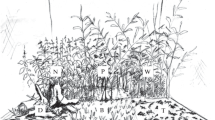Summary
This paper explores two hypotheses about the relationships among predation, thermoregulation, and wing color in butterflies: First, that butterflies are susceptible to predation during thermally marginal periods (e.g., cool weather) when effective thermoregulation and flight are not possible; second, that Pieris butterflies are relatively unpalatable to visual predators, supporting the idea that the white wing pigment of Pieris represents aposematic coloration. Field experiments with Pieris and Colias in 1984 and 1985 demonstrate that substantial predation may occur during the morning period before butterflies are able to actively fly. Circumstantial evidence is presented to suggest that at least some of the predation is by small, cursorial mammals. Feeding experiments in the field using Grey Jays as predators indicate that Pieris napi and P. occidentalis are less palatable than other sympatric butterflies, including confamial Colias alexandra. These and previous results suggest that Pieris are edible but less preferred as prey by birds, and that the degree of palatibility may vary among Pieris species. The relatively low palatability of these Pieris is consistent with the hypothesis that their white pigmentation represents aposematic coloration; however, the cues by which potential bird predators might discriminate against Pieris have not been established.
Similar content being viewed by others
References
Aplin RT, Ward RA, Rothschild M (1975) Examination of the large white and small white butterflies (Pieris spp.) for the presence of mustard oils and mustard oil glycosides. J Entomol A 50:73–78
Bowers MD, Brown I, Wheye D (1985) Bird predation as a selective agent in a butterfly population. Evolution 39:93–103
Brower LP (1984) Chemical defense in butterflies. In: The Biology of Butterflies, Ackery P, Vane-Wright R (eds), Academic Press, London, pp 109–134
Brower LP, Calvert WH (1985) Foraging dynamics of bird predators on overwintering monarch butterflies in Mexico. Evolution 39:340–349
Brower LP, Horner BE, Marty MM, Moffit CM, Villa R (1985) Mice as predators of overwintering monarch butterflies in Mexico. Biotropica 17:89–99
Calvert WH, Hedrick LE, Brower LP (1979) Mortality of the monarch butterfly (Danaus plexippus L.): Avian predation at five overwintering sites in Mexico. Science 204:847–851
Chew FS, Rodman JE (1979) Plant resources for chemical defense. pp. 271–307 in Herbivores: Their interaction with secondary plant metabolites, Rosenthal GA, Janzen DH (eds), Academic Press, New York
Christian KA, Tracy CR (1981) The effect of the thermal environment on the ability of hatchling Galapagos land iguanas to avoid predation during dispersal. Oecologia (Berlin) 49:218–223
Douglas MM, Grula J (1978) Thermoregulatory adaptations allowing ecological range expansion by the pierid butterfly, Nathalis iole. Evolution 32:776–783
Endler JA (1978) A predator's view of animal color patterns. Evol Biol 11:319–364
Endler JA (1984) Progressive background matching in moths, and a quantitative measure of cyrpsis. Biol J Linn Soc London 22:187–231
Ferris CS, Brown FM (1980) Butterflies of the Rocky Mountain states. Univ of Oklahoma Press, Norman
Herz PE, Huey RB, Nevo E (1983) Homage to Santa Anita: Thermal sensitivity of sprint speed in agamid lizards. Evolution 37:1075–1084
Huey RB (1982) Temperature, physiology, and the ecology of reptiles. pp. 25–91 In: Biology of Reptilia, Gans C, Pough FH (eds), Academic Press, New York
Jones FM (1932) Insect colouration and relative acceptability of insects to birds. Trans R Ent Soc London 80:345–385
Lane C (1957) Preliminary note on insects eaten and rejected by a tame shama (Kitticincla malabarica) with the suggestion that in certain species of butterflies and moths females are less palatable than males. Entomologist's Monthly Magazine 93:172–179
Kettlewell HBD (1965) Insect survival and selection for pattern. Science 148:1290–1296
Kingsolver JG (1985a) Butterfly thermoregulation: Organismic mechanisms and population consequences. J Res Lepidop 24:1–20
Kingsolver J (1985b) Thermoregulatory significance of wing melanization in Pieris butterflies: Physics, posture, and pattern. Oecologia (Berlin) 66:546–553
Kingsolver JG (1985c) Thermal ecology of Pieris butterflies: a new mechanism of behavioral thermoregulation. Oecologia (Berlin) 66:540–545
Kingsolver JG (1987) Evolution and coadaptation of thermoregulatory behavior and wing melanization pattern in pierid butterflies. Evolution 41:472–490
Lederhouse R (1983) Population structure, residency, and weather related mortality in the black swallowtail butterfly, Papilio polyxenes. Oecologia (Berlin) 59:307–311
Marsh N, Rothschild M (1974) Aposematic and cryptic Lepidoptera tested on the mouse. J Zool London 174:89–122
Pough FH, Brower LP (1977) Predation by birds on Great Southern White Butterflies as a function of palatability, sex, and habitat. Amer Midl Natur 98:50–58
Rawlins JE, Lederhouse RC (1978) The influence of environmental factors on roosting in the black swallowtail, Papilio polyxenes asterius. J Lep Soc 32:145–159
Rothschild M (1972) Secondary plant substances and warning colouration in insects; Symp R Ent Soc London 6:59–83
Rothschild M (1975) Remarks on carotenoids in the evolution of signals. In: Coevolution of animals and plants Gilbert LE, Raven PH (eds), Univ of Texas Press, Austin, pp 20–40
Shapiro AM (1974) Beak-mark frequency as an index of seasonal predation intensity of common butterflies. Amer Nat 108:229–232
Turner JRG (1977) Butterfly mimicry: The genetical evolution of an adaptation. Evol Biol 10:163–206
Turner JRG, Kearney EP, Exton LS (1984) Mimicry and the Monte Carlo predator: The palatability spectrum and the origins of mimicry. Biol J Linn Soc 23:247–268
Wallace AR (1889) Darwinism (1st ed). London
Watt WB (1968) Adaptive significance of pigment polymorphisms in Colias butterflies. I. Variation in melanin pigment in relation to thermoregulation. Evolution 22:437–458
Wourms M, Wasserman J (1985) Butterfly wing markings are more advantageous during handling than during initial strike. Evolution 39:845–851
Author information
Authors and Affiliations
Rights and permissions
About this article
Cite this article
Kingsolver, J.G. Predation, thermoregulation, and wing color in pierid butterflies. Oecologia 73, 301–306 (1987). https://doi.org/10.1007/BF00377522
Received:
Issue Date:
DOI: https://doi.org/10.1007/BF00377522




